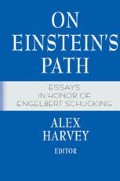Abstract
Hehl and collaborators [1] have suggested the need to generalize Riemannian geometry to a metric-affine geometry, by admitting torsion and nonmetricity of the connection field. They assume that this geometry represents the microstructure of space-time, with Riemannian geometry emerging as some sort of macroscopic average over the metric-affine microstructure. They thereby generalize the earlier approach to the Einstein-Cartan formalism of Hehl et al. [2] based on a metric connection with torsion. A particularly clear statement of this point of view is found in Hehl, von der Heyde, and Kerlick [3]: “We claim that the [Einstein-Cartan] field equations… are, at a classical level, the correct microscopic gravitational field equations. Einstein’s field equation ought to be considered a macroscopic phenomenological equation of limited validity, obtained by averaging [the Einstein-Cartan field equations]” (p. 1067).
Article Footnote
1Dedicated to Engelbert Schucking on his seventieth birthday with friendship and appreciation of his many contributions to science as a scholar and as a human being.
Access this chapter
Tax calculation will be finalised at checkout
Purchases are for personal use only
Preview
Unable to display preview. Download preview PDF.
Notes and References
Friedrich Hehl, J. Dermott McCrea, Eckehard W. Mielke, Yuval Ne’eman, “Metric-Affine Gauge Theory of Gravity: Field Equations, Noether Identities, World Spinors, and Breaking of Dilation Invariance,” Physics Reports 258 Nos. 1 & 2: 1–171 (1995).
See, e.g., Friedrich W. Hehl, Paul von der Heyde, G. David Kerlick“General relativity with spin and torsion: Foundations and prospects,” Reviews of Modern Physics 48 393–416 (1976).
Friedrich Hehl, Paul van der Heyde, and G. David Kerlick, General relativity with spin and torsion and its deviations from Einstein’s theory,“ Physical Review D10 1066–1069 (1974).
W. Adamowicz, “Equivalence between the Einstein-Cartan and General Relativity Theories in the Linear Approximation for a Classical Model of Spin,” Bulletin de l’Academie Polonaise des Sciences Serie des science, mathematiques astronomiques et physiques 23, 1203–1205 (1975).
In this section I follow an approach to electromagnetism well summarized in Attay Kovetz, The Principles of Electromagnetic Theory (Cambridge University Press, 1990), although I do not always follow his terminology and notation.
Strictly speaking, we should treat the G field as a tensor density field of weight one (see, e.g., John Stachel, “The Generally Covariant Form of Maxwell’s Equations,” in Melvin S. Berger, ed., J.C. Maxwell: The Sesquicentennial Symposium (Amsterdam/New York/Oxford: North-Holland, 1984), pp. 23–37. But since we are only introducing the electromagnic field for purposes of comparison, we avoid this complication here.
For a review of closed and exact forms, Poincare’s lemma, and the possible topological complications, see John Stachel, “Globally stationary but locally static space-times: A gravitational analogue of the Aharonov-Bohm effect,” Physical Review D 26 1281–1290 (1982).
Microscopic electrodynamics in a homogeneous, isotropic medium can be treated by introducing an “optical metric,” and even a nonlinear, phenomenological “vacuum polarization” can be introduced; both are discussed in the reference in note 6.
For such a careful treatment, see, e.g., Leon Rosenfeld, Theory of Electrons (Amsterdam: North-Holland, 1951), repr. with new Preface (New York: Dover, 1965).
For the definition of the Lie derivative, see e.g. Jan A. Schouten, Ricci-Calculus (Berlin/Gottingen/Heidelberg: Springer, 1954), pp. 102–111. For a review of the Lie derivative and its application to the Cauchy problem in general relativity, see John Stachel, “Covariant Formulation of the Cauchy Problem in Generalized Electrodynamics and General Relativity,” Acta Physica Polonica 35 689–709 (1969).
This is essentially what general covariance means. See, e.g., John Stachel, “The Meaning of General Covariance: The Hole Story,” in John Earman et al., eds., Philosophical Problems of the Internal and External World/Essays on the Philosophy of Adolf Griinbaum (Konstanz: Universitatsverlag/ Pittsburgh: University of Pittsburgh Press, 1993), pp. 129–160.
See, e.g., Hehl et al. (reference in footnote 2), p. 397. Note that I have placed the upper index first.
Jan Weyssenhoff and A. Raabe, “Relativistic dynamics of spinfluids and spin-particles,” Acta Physica Polonica 9 7-xx (1947).
For its definition, see, e.g., the reference in note 2.
Depending on the units used, the proportionality factor G may be introduced here.
See Schouten, reference in note 10, p. 141, Eq. (4.23a), remembering that Schouten’s T is defined with the opposite sign to K (see Eq. (4.20)), and that the trace of T vanishes in this case. Note that formula (4.23a) is true in an arbitrary affine-metric space, i.e., even if the nonmetricity tensor does not vanish, and we do not make the Weyssenhoff Ansatz for the torsion.
See reference in note 4.
Adamowicz speaks of a Weyssenhoff fluid, but the stress tensor of the body does not enter in the linear approximation, so it can be an arbitrary body.
We stipulate that the body be charged in order to have a better analogy with the gravitational case in which a body always has mass.
See the reference in note 1.
See, e.g., pp. 20, 22, Rosenfeld reference in note 9.
For the nonmetricity tensor, see the Hehl et al., reference in note 2, p. 397. Equations (2.8), (2.9) on that page show that the nonmetricity tensor would supply an additional term in the constitutive relation relating the metric-affine connection and the Christoffel symbols; and as noted in note 15, such a term could easily be included in the relation between the metric-affine and Christoffel Ricci tensors.
Reference in note 4, p. 1203.
See, e.g., Andrzej Trautman, “On the structure of the Einstein-Cartan equations,” in Differential Geometry, Symposia Mathematica, v. 12 (Academic Press, London 1973), p. 139.
See the reference in note 1.
Editor information
Editors and Affiliations
Rights and permissions
Copyright information
© 1999 Springer Science+Business Media New York
About this chapter
Cite this chapter
Stachel, J. (1999). On the Interpretation of the Einstein—Cartan Formalism. In: Harvey, A. (eds) On Einstein’s Path. Springer, New York, NY. https://doi.org/10.1007/978-1-4612-1422-9_33
Download citation
DOI: https://doi.org/10.1007/978-1-4612-1422-9_33
Publisher Name: Springer, New York, NY
Print ISBN: 978-1-4612-7137-6
Online ISBN: 978-1-4612-1422-9
eBook Packages: Springer Book Archive

